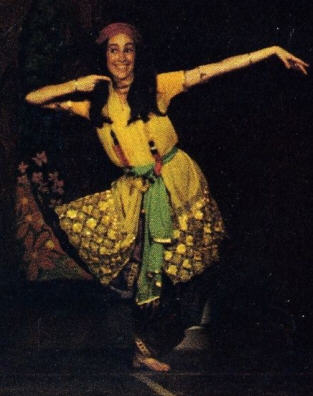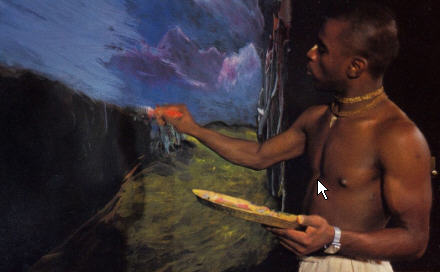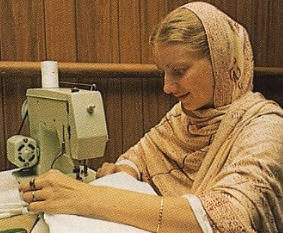
Many filmmakers and playwrights say that lately, fresh material has been awfully hard to find. Enter a young theatrical troupe, their material so ancient it's brand-new.
In New York City the news is getting around: a group of yoga students have formed an acting troupe and are entering the professional theater world.
Early in 1976, the International Society for Krishna Consciousness purchased a twelve-story building on Manhattan's West 55th Street (in the off-Broadway theater district). When the devotees told Srila Prabhupada that the center had a good-sized auditorium, his face brightened. Srila Prabhupada then called for Sudama Svami, the most experienced actor in the movement.
"Why don't you organize a theater in New York?"
Sudama Svami recalled that the subject of theater had come up at his first meeting with Srila Prabhupada, back in 1967. At that time, Srila Prabhupada had asked, "What do you do?"
"I love to sing and dance. I've done it ever since I was a young boy,'' Sudama Svami had replied.
"Very good. You can go all over the world and present Krsna conscious theater."
Srila Prabhupada's spiritual potency had so impressed Sudama Svami that he soon joined the movement. However, as a beginner in spiritual life, he wanted to get a deeper understanding of his new life-style before bringing theater into it. Now, after eight years, there seemed to be another obstacle.
"Now that I'm a sannyasi [renounced monk]," Sudama Svami asked Srila Prabhupada, "will this acting and dancing be considered a proper thing for me to do?"
"That is your sannyasa [renunciation]," said Srila Prabhupada. "Lord Caitanya Himself used to play in drama."* [*Lord Caitanya is an incarnation of Krsna who appeared in India five hundred years ago to popularize the chanting of Hare Krsna.]
This answer encouraged Sudama Svami. He remembered the many times that Srila Prabhupada had spoken vigorously against the idea that spiritual life requires a person to become inactive or to renounce his occupation. To support this point, Srila Prabhupada often quoted the verse in the Bhagavad-gita which says that a person who unselfishly performs his occupation "is in the renounced order of life, and he is the true mystic: not he who lights no fire and performs no work" (Bg. 6.1).
Srila Prabhupada acknowledged people's backgrounds. In the spirit of the Bhagavad-gita he would say, "Let him sing," "Let him paint," "Let him dance," "Let him do business…." "Yes, engineering construct temples. …" "These talents are not to be taken lightly. They should not be wasted. They are actually the result of austerities performed in previous lives and should be used in Krsna's service."
Sudama Svami's doubts were dispelled. To please his spiritual master, he would put together a professional theater company in New York.
In every nook and cranny of 340 West 55th Street, Sudama Svami could see the signs of new life. The drab, institutional colors on the walls (the building had been a hospital) had given way to bright reds, yellows, greens, blues, and oranges. The three hundred rooms, formerly filled with the dying, now housed energetic spiritual students who sang the Lord's glories, and the entire building vibrated with happiness and hope.
For Sudama Svami, the new center also meant the rebirth of a promising career that he had set aside ten years earlier. A strong theatrical streak ran in his family. His grandfather and grandmother, Willie and Bo Bo Covain, had choreographed several of Shirley Temple's movies and also had worked closely with Bill "Bojangles" Robinson, the master of tap dance. At age eleven, Sudama Svami had played in his first movie, Porgy and Bess. His work in James Baldwin's Amen Corner had nearly won him a part in West Side Story, on Broadway. By his sixteenth year he had earned a reputation as one of the most promising actors in Los Angeles.
"But in spite of my success," Sudama Svami said, "I lost my motivation. I was feeling frustrated. I wasn't frustrated materially I was well off but artistically speaking, I didn't have much depth." He dropped his acting to search for meaning. His search took him to San Francisco, where he lived for a year and a half with the Grateful Dead rock band, as a member of their "family." Still dissatisfied, he retreated to Ken Kesey's farm to reflect on his life. There he found and read three volumes of Srila Prabhupada's Srimad-Bhagavatam, which moved him so much that in 1967 he set off for India to learn directly from the author. But his journey ended in San Francisco. There he met some devotees, who asked him where he was going.
"To India," he told them.
"Why?"
"To meet the man who wrote this book."
"That's our teacher. He's staying right here in San Francisco." Srila Prabhupada and some of his early disciples had just opened a temple, and before long, the young actor decided to stay a while.
"When the devotees started doing drama," Sudama Svami recalled, "it was fairly amateurish." But in 1971 Srila Prabhupada wrote to one of the actors, "One day, very soon, your dreams will come true and you will be acting our Krsna conscious dramas on Broadway." If Srila Prabhupada said that the players would make Broadway, then Sudama Svami was convinced that it would happen through spiritual purity, perfect technique, and tons of practice. He reassembled a workable company in New York before the end of April.
Returning from India with Sudama Svami were a husband-and-wife team, Lohitaksa dasa and Rasajna-devi dasi. Their experience before taking up Krsna consciousness was like that of the other players. They had studied their art intensely; then, after becoming professionally involved, they had found nothing meaningful to express. At this point, they had opened their minds to new possibilities. After coming in touch with the Krsna consciousness movement, they had decided to join.
Lohitaksa dasa's forte is ballet. He studied with Alfredo Corvino, the American Ballet Theater, and Ballet Arts and then danced professionally with the New Jersey Ballet Company. To him the essence of theater always seemed to be spiritual. "But in my work," he said, "the spiritual side never manifested itself to me."
His wife, Rasajna, studied acting with a group called the Player's Workshop and performed with them more than seven years, in both Germany and New York. She was branching out into films and a part with the Metropolitan Opera when she and her husband first visited the Hare Krsna center. By acting she gained some insight into reincarnation. "I didn't know exactly what it was," she said, "but I had some idea that I had been through many, many lifetimes. The tip-off was that I could play certain characters almost at once, without any prior experience of them in this lifetime."

In reminiscing about his first exposure to Krsna conscious theater, Lohitaksa dasa said, "It wasn't much technically, but the material was so fantastic. I thought, 'This is for me.' I wanted to do theater that elevated people and allowed them to transcend time and space and their bodies, and this theater seemed to do just that." His wife agreed, and six reeks later they moved into the center.
By the time rehearsals began, in April, here were ten members: eight actors and actresses (four of whom had done work in dance) and two stagehands. "To get the company on its feet," said Sudama Svami, "I worked everyone from nine in the morning to nine at night. Many of the players balked. They couldn't imagine that it required so much time and energy, but I was firm and soon everyone came around."
The company is developing a wide repertoire that ranges from street theater to straight drama, and from musical comedy to pure dance. On a typical day, not only do the players sharpen their acting and dancing skills, but also they rehearse as many as three pieces.
The main dancers, Lohitaksa dasa and Satarupa-devi dasi, attend professional dance classes daily, mostly at Maggie Black's. "The classes are intense," said Satarupa-devi dasi. "They often last two and a half hours. You start with slow stretching exercises, work your way up to fast footwork, then to small jumps, and finally you're running, leaping, and jumping across the room."
Before and after the classes, many of the top dancing stars ask Satarupa-devi dasi about her experiences in Krsna consciousness. Often she tells them about the similarities between dance and spiritual life. "Dance is such a discipline forcing your body into the various postures. Your body and even your mind tires, but you keep going. Spiritual life demands the same discipline and dedication. Our bodies and minds are lazy. They cling to their selfish ways, so you have to coax them. And when you perfect your discipline in dance your movements assume a natural beauty and grace, and in Krsna consciousness you attain inner happiness and peace."
Because of the company's small size, the players don't confine themselves to working on stage. Sudama Svami serves as overall producer and coordinator. Rasajna designs and makes the costumes. Lohitaksa doubles as the acting coach. Prajapati dasa (who along with Satarupa forms the company's second husband-wife team) acts, directs, and designs the sets. "There are no stars here," said Prajapati dasa. "Everyone pitches in on whatever needs to be done."
Street Theater
You're walking down crowded Fifth Avenue. The urban tension grips your shoulders and you daydream about getting away from it all for a few days. Suddenly, over the traffic's roar you hear a man screaming. "Help! Help! Help! I'm drowning! Help!"
Drowning on Fifth Avenue?
You turn your head, and your feet, toward whatever's going on.
"Oh, no! Marvin! Someone help! Please! My husband's drowning!" cries a tall blonde, her face distorted by grief.
By now you are part of a sizable crowd, all eyes and ears fixed on the unfolding drama.
An official-looking man in an olive suit struggles out from among the onlookers.
"Don't worry, ma'am," he says. "I'll save that poor guy! I'm a social worker! Saving people is my business! Look. The hungriest come to me. If they need a shirt on their back, they come to me. If the sheriff throws them out on the street, they come to me.If they need a "
"Please hurry or it'll be too late!" pleads the blonde.
The social worker tears off his jacket and "dives" into the imaginary lake. He swims to the drowning man, grabs him, then starts pulling him back to the shore. The victim struggles, and, reluctantly, the social worker subdues him with a punch. At this point, the drowning man slips out of his jacket. Then the social worker strokes his way back to land.
He yells, "Everything's OK! I told you I'd take care of him! Here he is, ma'am! I told you! I told you I'd save him!"
"Marvin?,.. AAAAAAAAAHHH!! You fool! You didn't save Marvin! You saved his coat!"
Now another member of the company steps up and says, "The moral of this story is that while a social worker can alleviate a person's material problems (or save his coat), he can't begin to help the real person living inside the body (or the soul). Only by taking up a spiritual process can we do that. And in this age, the easiest and most recommended process is to chant the Hare Krsna mantra:
When the company performs The Drowning Man, people clap and shout "More! More!" "Many people think that street theater started with the antiwar skits during the sixties," Sudama Svami noted. "But actually, if you study the history book of Indian drama, you'll discover that street theater originated five hundred years ago in Bengal, with Lord Caitanya Mahaprabhu. He wanted to show people about spiritual life and help them remember God Krsna."
The Age of Quarrel
In May the company completed its first stage piece. The Age of Kali, penned by Girish Candra Ghosh, the "Shakespeare of Bengal." "He was a brilliant author," says Sudama Svami. "He'd sit with a secretary on either side and dictate two plays at once."The Age of Kali closely resembles a medieval morality play, and perhaps a little amazingly, it is the company's most popular work.
Prajapati dasa explained, "Kali is the personification of evil. He destroys everyone's good qualities. In the Western world the closest thing to Kali is the devil, but Kali isn't some ghoul with pointed horns. He looks quite respectable dressed in high style, and so forth. In this day and age, he's the trendsetter."
Sudama Svami plays Kali. He paces onto the stage through an eerie fog, and "Sin" (Rasajna-devi dasi) accompanies him. This is Kali's age to rule, and he and Sin talk over their strategy.
Kali: With perverted desires will I flood their minds. They'll be vultures for pleasure, but only torment find.
Sin: Sexual perversions will be in vogue. Oh, Kali, Kali, you're such a rogue. Sin is Kali's faithful servant.
Sin: What would you like for dinner, dear? Some freshly killed cow, chicken, or deer? Government-inspected turkey, rabbit, or lamb?
Kali: No, tonight I'll eat my fellow man! Kali signals the decline of God-consciousness.
Kali: Worship of God? Ha! There'll hardly be any. But even the pauper will worship his penny.
Kali and Sin conclude the first act by confronting the audience.
Kali and Sin: We're planning all the trouble the world's gonna be put in.
Kali: For I'm Kali.
Sin: And I'm his consort Sin.
Kali and Sin: This is the age that'll do you all in!
The rest of the play takes place in Sin's court, where she is surrounded by her cohorts Lust, Anger, and Greed. A depressed Kali trudges in with sad news: Lord Caitanya Mahaprabhu has incarnated and is spreading the chanting of God's holy names in every town and village. Now their corrupt regime is doomed. Sin is outraged and vows to fight right down to her last vice. But from offstage the audience hears the sound of chanting grow louder and louder.
Playwright Diane Richards is so intrigued with Kali she has offered to turn it into a full-length musical. "We haven't reached anywhere near perfection yet," admitted Sudama Svami, "but the reaction from the rest of the theatrical community is very encouraging." He accounts for Kali's popularity in this way: "The Age of Kali has beautiful effects fog, strobes, colored wheels, flamboyant costumes and dance and upbeat music. And Kali fits right into this whole 'Exorcist' trend. There's lust. There's anger. There's greed. These are real forces that bewilder everybody. In Kali they come to life, and the audience feels relief to see them subdued."

The troupe performs The Age of Kali in rotation with other works adopted from the classical Vedic literatures of India. From the Srimad-Bhagavatam they enact dramas and dance pieces depicting the pastimes of the Supreme Lord, Krsna. They combine dance and drama in their portrayal of the worldly famous Bhagavad-gita. Most recently, they're working on a full-length production from the epic Ramayana.
These plays provide relief from a modern theater addicted to anti-heroes, alienation, and commercial fluff. They portray great personalities who meet tremendous challenges with spiritual strength. In the Bhagavad-gita Krsna slashes away the doubts of his disciple Arjuna with the weapon of transcendental knowledge. In the series about Krsna's pastimes, the youthful heroes Krsna and Balarama do away with demons such as the kidnapper Pralambasura.
"These plays both entertain and present spiritual life in a pleasing way," said Rasajna dasi. "It's a natural form of enlightenment both for the players and the audience, and for me that's the perfection of theater."
Does Sudama Svami have a timetable for the company's debut on Broadway?
"We're in no hurry," he said. "After all, by uniting Vedic and Western theater the troupe is creating a new art form and that's not something you do overnight. Besides, I quit my career ten years ago, and then Krsna (through Srila Prabhupada) gave me another chance. So I've learned one thing it's Krsna's timetable, not mine."
